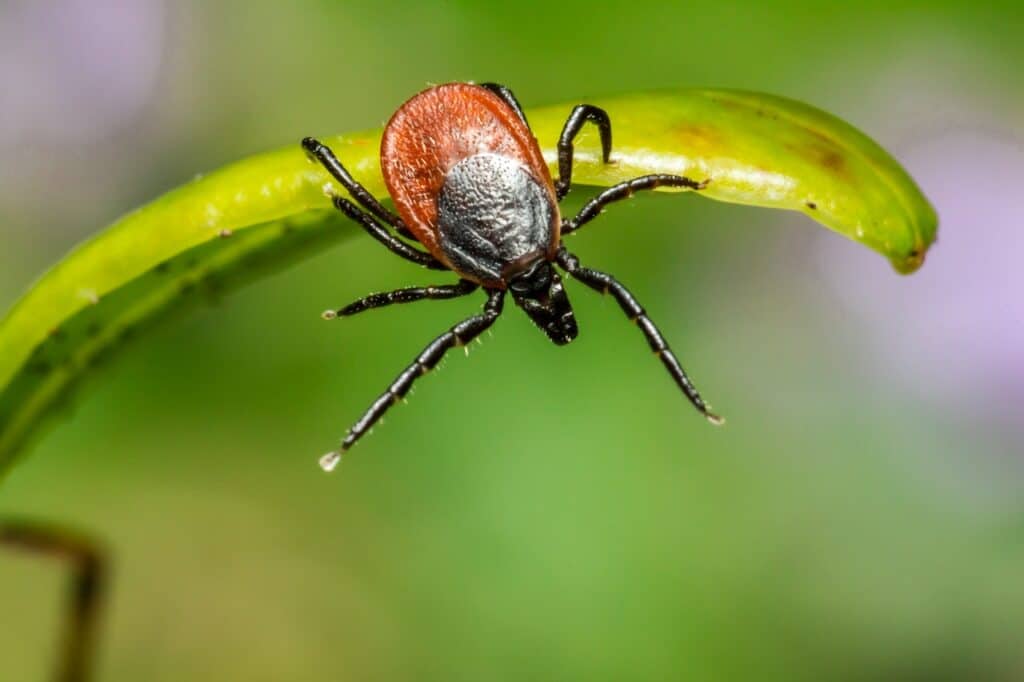Preventing Tick Bites in Southern California

When California weather is excessively rainy, it can mean a greater chance of tick exposure and tick bites. These microscopic disease-carrying arachnids like wet wooded areas, and more recently, they’ve taken to hanging out at the beach. While most people think of tick bites and their resulting Lyme disease infections as an East Coast concern, California is home to disease-carrying ticks. Preventing tick bites in Southern California is something you should pay attention to while being outdoors.
What are the Chances of Being Bit by a Tick in California?
 Surveys from the Bay Area Lyme Foundation report more disease-carrying ticks in the state than ever because of climate change. Though Northern California has a higher population of ticks because of wetter weather, wine country vineyards, and woodlands, researchers say that ticks are also present in Southern California. Nearly half of all ticks on the East Coast carry the bacteria responsible for Lyme and other related diseases. In contrast, about 4% of California’s ticks carry diseases. Tick hot spots include woods, grasslands, and beach grass in Mendocino, Sonoma, Napa, Marin, Santa Clara, Santa Cruz, Monterey counties, Malibu, Manhattan Beach, and Newport Beach.
Surveys from the Bay Area Lyme Foundation report more disease-carrying ticks in the state than ever because of climate change. Though Northern California has a higher population of ticks because of wetter weather, wine country vineyards, and woodlands, researchers say that ticks are also present in Southern California. Nearly half of all ticks on the East Coast carry the bacteria responsible for Lyme and other related diseases. In contrast, about 4% of California’s ticks carry diseases. Tick hot spots include woods, grasslands, and beach grass in Mendocino, Sonoma, Napa, Marin, Santa Clara, Santa Cruz, Monterey counties, Malibu, Manhattan Beach, and Newport Beach.
The Centers for Disease Control estimate that about 476,000 people get Lyme disease yearly in the United States. Lyme disease is caused by the bacterium Borrelia burgdorferi and, rarely, Borrelia mayonii. It is transmitted to humans through the bite of young infected black-legged ticks. The site may or may not cause a noticeable rash within a week of being bit. Symptoms may include fever, fatigue, headache, and flu-like symptoms. If left untreated, it can be debilitating and damaging to joints, heart, and nervous system and may require a more comprehensive integrative medical treatment for Lyme disease.
Athletes Are More Susceptible to Tick Bites
The amount of time athletes spend outdoors means they are more prone to tick bites, even in California. This is especially true for runners, hikers, and mountain bikers. If you travel for training or competition, the risk of tick bites is higher. Follow basic guidelines, plus prevention guidelines before and after going outdoors as mentioned below. Always stay on the trail or path in wooded areas, apply natural tick repellant, and wear quick-dry clothing, hats, and close-toed shoes with socks.
Preventing Tick Bites Before Going Outdoors
- Wear light-colored clothes and hats: Seeing ticks on white and lighter-colored clothing is easier.
- Wear long sleeve shirts and long pants in quick-dry fabrics: Ticks love moisture and thrive in humidity. Ticks cannot readily cling to clothing made from quick-dry materials.
- Wear close-toed shoes: Ticks hang around in leaves and scrub on the ground. Bare feet are an easy way for them to hitch a ride.
- Use a natural tick repellant: Many tick repellents on the market contain harsh chemicals such as permethrin or DEET, which can have adverse neurological health consequences, especially for children. However, lemon-eucalyptus essential oil (derived from the Eucalyptus citriodora plant) is registered with the EPA as a repellant. Do not use it directly on the skin, find a premade repellant containing lemon eucalyptus (OLE) oil. Read more on tick repellants from the CDC.
Preventing Tick Bites After Coming Indoors
- Lint-roll your clothes before getting in the car after hiking, walking, or hanging out at grassy beach areas.
- Place your clothes and jackets in the dryer on high heat when home.
- Check your pets. Ticks often latch onto animals after they’ve been outside and hop off onto furniture and bedding. Ask your veterinarian about how to prevent ticks on your pets.
- Do a thorough full-body tick check using a mirror. Pay attention to moist warm areas like armpits, groin, and anywhere you sweat. Ticks are not any bigger than a freckle, so look carefully.
- After your tick check, take a shower and wash up well. Look and feel for any bumps.
- If you find a tick, it’s essential to remove it immediately. This can be done using tweezers to grasp the tick as close to the skin as possible and pull it straight out.
Making Your Yard an Unattractive Home for Ticks
Ticks love leaves, yard waste, wood piles, stone walls, and other high-humidity environments. The following chores will help make ticks less attracted to your yard:
- Remove dead leaves, brush, and other natural debris from your yard.
- Keep grass and shrubs trimmed.
- Create stone and gravel paths instead of all grass walkways.
- Place tick tubes in your yard. White-footed mice are known to be carriers of Borrelia burgdorferi, the cause of Lyme disease. Black-legged tick larvae contract the bacteria when they feed on these mice. Tick tubes are filled with cotton laced with permethrin; the mice take the treated cotton back to their nests, killing the ticks at the larvae stage. It does not harm the mice, and the tubes are biodegradable. Tick tubes are available at hardware stores and on Amazon.
Don’t be fooled; ticks are a common problem in Southern California. Following these steps can reduce your risk of getting a tick bite. Wearing protective clothing, using a repellent, checking for ticks, and taking steps at home to remove their habitat are critical in preventing tick bites.
If you live in Southern California and believe you have contracted Lyme disease, don’t hesitate to contact our clinic to learn more about how we use integrative medicine to treat Lyme and long-haul Lyme.

